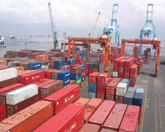Tanjung Priok, Indonesia's busiest port, has started relocating containers at its yard in the wake of congestion, triggered by heavy traffic flow.
The yard occupancy ratio (YOR) in the container terminal at Tanjung Priok reached 130 percent early this week or 30 percent above the maximum limit.
Other ports in several regions are also exposed to the same situation due to limited container loading and unloading equipment.
Some suspect the congestion has something to do with the search of the Tanjung Priok Custom and Excise Office by the Corruption Eradication Commission (KPK) on May 30. The search has made the Custom and excise officers more careful in examining documents and delaying the clearance of containers.
In an effort to reduce the container pile at the port, the Customs office has approved requests to relocate thousands of import containers to other yards.
"Every day there are around 128 requests that the Custom and Excise Office receives f or the relocation of thousands of containers," he said to Bisnis yesterday.
Because of the relocation drive, the YOR at the Jakarta International Container Terminal (JICT) has dropped to 80 percent, at the Koja Container Terminal down to 85 percent, at the Dwipa Container terminal sharply down to 45 percent, and at the Mustika Alam Lestari Container terminal, the YOR is down to 70 percent.
Customs authorities said the requests to relocate containers would be free of charge since such an action aimed to anticipate crowded container traffic.
Meanwhile, the Ministry of Transportation has urged state port operator (Pelindo) I, II, III, and IV to modernise facilities and infrastructure at its terminals.
The pile-up of containers takes place at various Indonesian ports because of inadequate equipment for moving containers and a lack of infrastructure. Besides Priok, other ports affected are Pontianak, Soekarno-Hatta Makassar, Teluk Bayur Padang and Belawan Medan.
The pile-up at Pontianak and Tanjung Perak Surabaya ports were mainly caused by limited container loading-unloading devices, while the situation at Priok was that besides the lack of equipment, several roads inside the port were damaged, slowly the moving of the boxes.
CargonewsAsia













